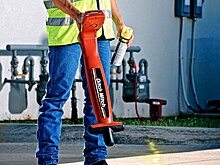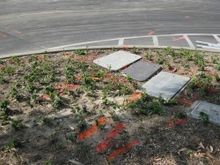Utility location
This article includes a list of general references, but it remains largely unverified because it lacks sufficient corresponding inline citations. (July 2013) |

Utility location is the process of identifying and labeling public utility mains that are underground. These mains may include lines for telecommunication, electricity distribution, natural gas, cable television, fiber optics, traffic lights, street lights, storm drains, water mains, and wastewater pipes. In some locations, major oil and gas pipelines, national defense communication lines, mass transit, rail and road tunnels also compete for space underground.[1]
Description[]
Public utility systems are often run underground—some by the very nature of their function, others for convenience or aesthetics. Before digging, local governments often require that the underground systems' locations be denoted and approved, if it is to be in the public right-of-way.
Because of the many different types of materials that go into manufacturing each of the different types of underground lines, different detection and location methods must be used. The two general methods are called passive locating and active locating.[2]
Passive locating uses signals that occur naturally on some utility lines. This method often fails to locate 60% or so of utility lines, and misidentifying utilities is an associated risk. Active locating, on the other hand, is more accurate. It makes use of signals that the locators generate through a transmitter. Then, with the help of a receiver, locators can trace as well as identify what type of utility line lies underground.[2]
The active method is the most suitable for locating metal pipes and cables. This process often involves using a piece of electromagnetic equipment, consisting of a transmitter and a receiver. For other types of pipe, such as plastic or concrete, other types of radiolocation or modern ground-penetrating radar must be used. Location by these technical means is necessary because maps often lack the pinpoint precision needed to ensure proper clearance. In older cities, it is especially a problem since maps may be very inaccurate, or may be missing entirely.
A few utilities are permanently marked with short posts or bollards, mainly for lines carrying petroleum products. This may be done because of venting requirements, and also serves to indicate the location of underground facilities that are especially hazardous if disturbed.
Locating underground utilities within the vicinity of an area is also a must. This vicinity, also called the tolerance zone,[3] usually extends between 18 to 24 inches laterally from the position of a utility line and along its entire length. The specific distance varies from state to state, so it is a must for locating professionals to confirm the specifics with the State that covers their work area.[3]
Telephone hotlines[]
"Call before you dig", "Know What's Below! Dig With Confidence!", "Dial before you dig", "Digger's Hotline", "One-call", "Miss Utility", "Dig Safe", "Click before you dig", or Underground Service Alert are services that allow construction workers or homeowners to contact utility companies, who will then denote where underground utilities are located via color-coded markings typically up to and not past the user's service connection or meter. Lines on the other side of the meter or service connection are considered to be part of the customer's property and will typically not be located by these services.
Failure to call such a number ahead of time may result in a fine or even a criminal charge against a person or company, particularly if such negligence causes a major utility outage or serious accident, or an evacuation due to a gas leak. Hitting a water main may also trigger local flooding or require a boil-water advisory.
The following are the partial list of countries with one-call for utility location:
- Australia: The national "dial before you dig" number is 1100.[4]
- Canada: In Canada, there is no unified number for the country. However, it has the "Click Before You Dig" website that provides access to the hotline for each of the provinces.[5]
- New Zealand: Each utility is responsible for marking its own services. A private company (https://www.beforeudig.co.nz/) has been contracted by many utilities and city councils to provide one-call services and corridor access requests. A person planning to dig in the public roadway can lodge a ticket with BeforeUDig and have the utilities in the area notified who in turn will respond with maps of their assets.
- United States: As required by law and assigned by the US Federal Communications Commission (FCC), the 8-1-1 telephone number is used for this purpose across the United States.[6]
- United Kingdom: In Scotland there is an online web based service called Vault[7] (short for Scottish Community Apparatus Data Vault), which allows registered users to specify a polygon on a map and immediately obtain an interactive map of all major undertakers owning underground assets, except the principal telecoms operators). In the rest of the UK, there is no dial-before-you-dig service. Instead the onus is on excavators to ensure that they do not damage buried services.[8] This has resulted in a class of locating tools which are simpler to use, and are called Cable Avoidance Tools (CATs), and the associated signal detectors are called Gennys.
Color-coding[]


Utility color codes are used to identify existing underground utilities in construction areas, to protect them from damage during excavation. Colored lines, flags, or both are used to mark the location and denote the type of underground utility. A special type of spray paint, which works when the can is upside-down, is used to mark lines, often in a fluorescent color. On flags, a logo often identifies the company or municipal utility which the lines belong to.
Flags may also be an advertisement for a company which has installed an irrigation system for lawns or gardens. In this case, each sprinkler head is usually marked, so that landscaping crews will not cover or bury them with soil or sod, or damage them with tractors or other construction equipment while digging holes for trees, shrubs, or other large plants or fenceposts. This is also important because a vehicle (tractor, truck, or otherwise) can break a sprinkler or the hard-PVC pipe or joint it is mounted on, simply by driving over it, particularly on newly moved soil which is uncompacted and therefore unsupportive of such weight.
Australia[]
The national standard for Australia uses the following color guide:[4]
Orange electricity Yellow gas Blue water White communications Red fire services Cream sewerage Purple reclaimed water Silver/Gray steam Brown oils, flammable liquids Light blue air Pink Unidentified services Black other liquids
New Zealand[]
There is no legal colour code requirements for buried utilities and surface markings, however a general convention is used and encouraged by the government health and safety department - Worksafe.[9]
Underground Duct Surface Marking Colour Surface Marking Letter Utiltiy Orange Orange E Electricity Yellow Yellow G Gas Blue Blue W Water White Green Purple T Telecommunications, commonly used by Chorus for copper and fiber optic cables. Light Grey Red SS Waste Water / Sewer Dark Grey Pink SW Storm Water / Drainage Red Regional Utility Specific, commonly used by UFF for fiber optic cables. Purple Regional Utility Specific, known to be used by Telstra Saturn Cable Television Light blue Regional Utility Specific, known to be used by Telstra Clear Pink Regional Utility Specific Black Most commonly used for non-potable water on farms however can be an outer duct for roadside utilities. Worksafe encourages the use of a 5mm wide or larger coloured stripe to indicate the content of the black duct using one of the color codes above.
A plain black microduct or 2-pair telephone cable is often used by Chorus for premises drop cables.
United Kingdom[]
The national standard for the United Kingdom uses the following color guide:[10]
Red electric power lines, conduit, and cables Orange telecommunication, alarm or signal lines Yellow gas, oil, steam, petroleum, or other flammable material Green sewage and drain lines Blue drinking water Purple reclaimed water, irrigation, and slurry lines Pink temporary survey markings, unknown/unidentified facilities White proposed excavation limits or route
India[]
India uses a convention similar to the US, for marking underground utilities such as telephone, gas, water and electricity. The system is based entirely on convention without any written standard. These markings are color-coded, and are painted by contractors onto the pavement.[11]
The main colors based on the convention are used in the same way as in the US: red for electricity, yellow for gas, and blue for water. However, other colors have other meanings. Green is used for telecommunication conduits. White is used as general communication between contractors; white is also used to note the details of road surface markings so that markings can be easily restored after the road construction is completed; a few telecommunication companies also use white color for their utility locations. Orange and other colors are used by local authorities to mark improvements and other details not related to utility locations.[11]
Canada & United States[]

Canada and the United States use the American Public Works Association (APWA) Uniform Color Codes for temporary marking of underground utilities:[12][13][14][15][16]
Red electric power lines, cables, conduit, and lighting cables Orange telecommunication, alarm or signal lines, cables, or conduit Yellow natural gas, oil, steam, petroleum, or other gaseous or flammable material Green sewers and drain lines Blue drinking water Purple reclaimed water, irrigation, and slurry lines Pink temporary survey markings, unknown/unidentified facilities White proposed excavation limits or route
Some municipalities use the pink paint to make lines and codes on the pavements related to required street improvements such as ramp replacement, asphalt grinding and form injection. These markings are not related to utility locating.[17]
See also[]
- Dynatel, a product line of utility locators and markers
- Subsurface utility engineering
- Underground Service Alert
References[]
- ^ "USDA Utilities". USDA. Retrieved October 5, 2013.
- ^ a b Salazar, D. (2020). Underground Locators: Everything You Need to Know. Engineer Warehouse Learning Center. Retrieved 06 June 2020.
- ^ a b Occupational Safety and Health Administration. (2018). "OSHA Training Toolbox Talk: Working Safely Around Underground Utilities at Excavation Sites" (PDF). OSHA Training.
- ^ a b "Dial before you dig - Working near power cables" (PDF). Energex. Retrieved 1 February 2018.
- ^ "Click Before You Dig". Canadian One-Call Centres Committee and the Canadian Common Ground Alliance. Retrieved 21 October 2014.
- ^ "811. Know what's below. Call before you dig". call811.com. Common Ground Alliance. Retrieved 2013-07-24.
- ^ "Vault". www.roadworksscotland.gov.uk. Retrieved 2017-11-10.
- ^ "Avoiding danger from underground services". Health and Safety Executive (UK). Retrieved 24 April 2017.
- ^ "Guide for Safety with Underground Services - Page 29". Retrieved 27 November 2021.
{{cite web}}: CS1 maint: url-status (link) - ^ "UNDERGROUND UTILITY COLOUR CODES EXPLAINED". Cornerstone Projects Ltd. Retrieved 25 July 2019.
- ^ a b Cawley, Laurence (2014-02-18). "What do those squiggles on the pavement actually mean?". BBC News. Retrieved 19 February 2014.
- ^ "APWA Uniform Color Code" (PDF). American Public Works Association. Retrieved 7 May 2014.
- ^ "How Do I Interpret Locate Markings/ Documentation?". Dig Safe (Ontario). Retrieved 21 October 2014.
- ^ "FORMS AND SAFETY TIPS". BC One Call. Retrieved 21 October 2014.
- ^ "Colour code". Info-Excavation (Quebec). Retrieved 21 October 2014.
- ^ "Color Code Explanation". Alberta One–Call. Retrieved 21 October 2014.
- ^ "Street Marking Explanations". City of Fort Collins. Retrieved 9 May 2014.
- Technology Transfer Information Center. "Statement of Need: Utility Locating Technologies". Accessed October 31, 2007.
External links[]
- American Public Works Association, an organization of public works professionals
- National Utility Locating Contractors Association, a utility locating organization
- How Does a Utility Locator Work?, the fundamentals of utility locating
- Color codes
- Public utilities
- Subterranea (geography)
